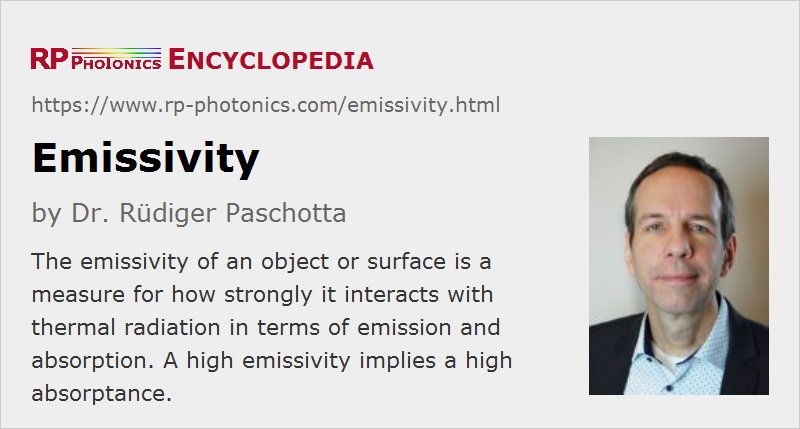Emissivity
Definition: a measure for how strongly an object emits and absorbs thermal radiation
German: Emissionsgrad
Units: (dimensionless)
Formula symbol: <$\epsilon$>
Author: Dr. Rüdiger Paschotta
Cite the article using its DOI: https://doi.org/10.61835/fqq
Get citation code: Endnote (RIS) BibTex plain textHTML
The emissivity of an object or a surface is a measure for how strongly it interacts with thermal radiation in terms of emission and absorption. It can have a value between 0 and 1, and it can be dependent on the optical frequency or wavelength, also on the direction of incidence and the polarization of light.
The maximum possible emissivity of 1 would imply that incident radiation is completely absorbed, and for a given temperature the object then emits thermal radiation with the maximum strength. Such an object is often called a black body.
Objects with lower emissivity emit less light, but also reflect or scatter more light. The connection between emissivity and absorptance (reciprocity principle) is expressed by Gustav Kirchhoff's law of thermal radiation. It can be verified by considering the thermal equilibrium in certain situations. For example, if two bodies of different emissivity but at the same temperature exchange thermal radiation, then the power of thermal radiation from one object to the other must be exactly the same as that power in the other direction. Otherwise, one would obtain a net energy flow which could build up a temperature difference; that would cause a violation of the second law of thermodynamics.
Example Cases
Ordinary uncoated window glass has a rather low emissivity in the visible spectral range; it does neither absorb nor emit such radiation, but largely transmits it. Four long wavelengths, however, the emissivity of such glass becomes rather large (more than 0.8). This is what is relevant for the exchange of thermal energy around room temperature. Therefore, uncoated window glass can lose substantial amounts of heat by thermal radiation and not only by convection of air. There are certain low-emissivity coatings with which the thermal insulation properties of windows can be improved – by reducing thermal emission in addition to the thermal conductance.
For a heater or a radiative cooler, it is usually desirable to have a high emissivity, so that the desired thermal power can be released at a lower temperature of the device. Again, the emissivity in the infrared region is relevant, not the emissivity for visible light. With an appropriate coating, a heater can look white and nevertheless have a high emissivity in the infrared.
The method of thermography is often used for remote temperature sensing, e.g. for detecting energy losses of buildings or temperatures of hot machine parts. Here, one needs to take into account that the intensity of thermal radiation depends not only on the temperature, but also on the emissivity of the material. Fortunately, the emissivity of many building materials is relatively high, so that the received radiation intensity depends mainly on the temperature of the object and not too much on the intensity of incident thermal radiation.
More to Learn
Encyclopedia articles:
Questions and Comments from Users
Here you can submit questions and comments. As far as they get accepted by the author, they will appear above this paragraph together with the author’s answer. The author will decide on acceptance based on certain criteria. Essentially, the issue must be of sufficiently broad interest.
Please do not enter personal data here; we would otherwise delete it soon. (See also our privacy declaration.) If you wish to receive personal feedback or consultancy from the author, please contact him, e.g. via e-mail.
By submitting the information, you give your consent to the potential publication of your inputs on our website according to our rules. (If you later retract your consent, we will delete those inputs.) As your inputs are first reviewed by the author, they may be published with some delay.

 general optics
general optics
Share this with your friends and colleagues, e.g. via social media:
These sharing buttons are implemented in a privacy-friendly way!